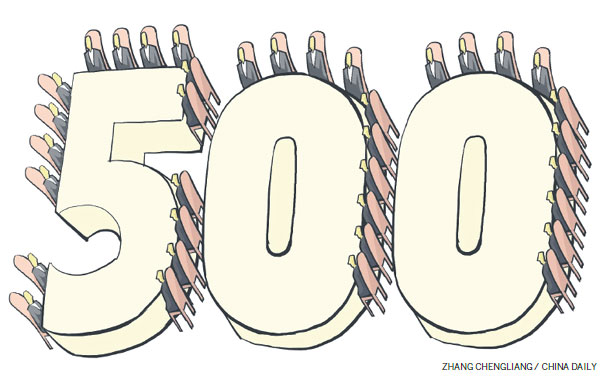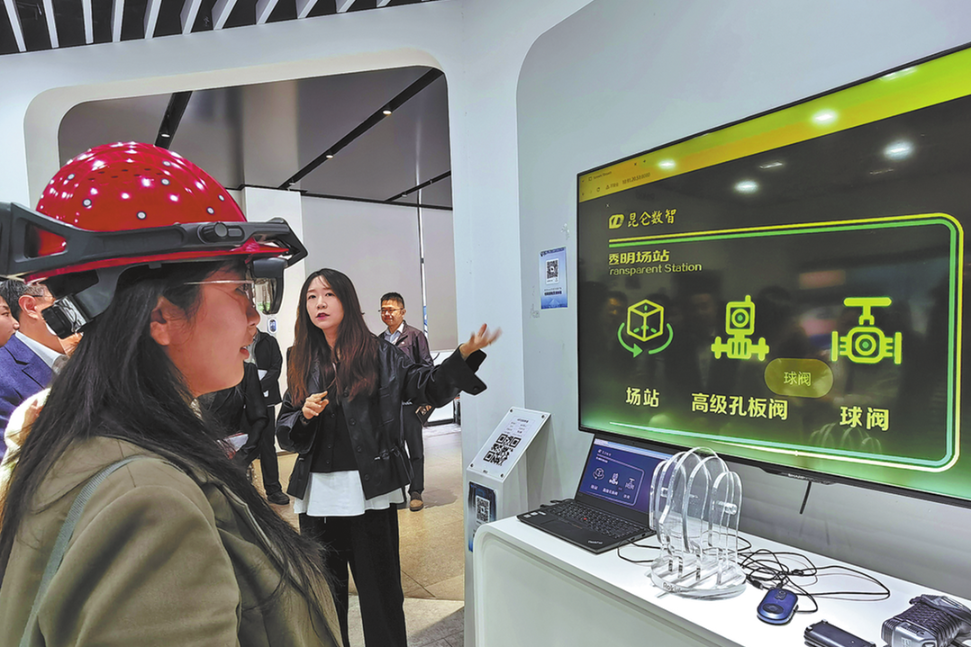Chinese climbing Fortune Global 500

With 10 newcomers, diversity of industrial sectors represented on the list is noteworthy
The Fortune Global 500 list of the world's most valuable companies was released on July 20, and once again Chinese companies are firmly in the ascendancy.
A grand total of 115 Chinese companies (up from 98 last year) appear on this year's prestigious Fortune Global 500 list, which marks the 14th consecutive year in which the number of Chinese companies has risen.
Before discussing the Chinese corporate "heavy hitters", it is noteworthy that 10 Chinese companies were "new entrants" on the list.

The diversity of industrial sectors in which these and other Chinese companies are based is also noteworthy.
In addition to energy and finance, sectors as varied as real estate, architecture and engineering were all represented by this growing number of increasingly global Chinese companies, with most of the new entrants from the trade and technology sectors.
Chinese internet (and rapidly diversifying entertainment) giant Alibaba - ranked 462nd with revenue of $22.9 billion (19.7 billion euros; £17.6 billion) - is among the Chinese companies appearing for the first time in the Fortune 500, while others debutants include insurance giant Anbang Group (ranked 139th with revenue of $60.8 billion) as well as one of Alibaba's archrivals, technology giant Tencent (ranked 478th with revenue of $22.87 billion).
In addition to the strong showings in the financial services, entertainment and technology sectors, Chinese property sector giant Country Garden also makes the list for the first time.
But arguably the most remarkable riser on the list is HNA Group, whose product brands include Hong Kong Airlines. HNA Group jumped from a ranking of 353rd last year to 170th this year.
Returning to the Chinese corporate "heavy hitters", energy sector titans State Grid Corp and oil giant Sinopec raced up to second and third on the list, respectively, with revenues last year of $315 billion and $268 billion, respectively. China National Petroleum also made the top 10, finishing in fourth place.
While Apple Inc topped the profitability list among the top 500, with an incredible $45.7 billion profit in the last fiscal year, China's four major commercial banks (Industrial and Commercial Bank of China, China Construction Bank, Agricultural Bank of China and Bank of China) followed close behind.
Further signs of global strength among Chinese financial corporations were shown by insurance giant Ping An, which made the top 40 this year.
So, does this send a clear message as Chinese industry continues to forge ahead in its transition from an over-reliance on low-cost production, low price and economies of scale toward a more modern business culture in which investment replaces cost and premium brand building replaces low-priced products?
It most certainly does.

A clear picture is emerging here where Chinese companies are concerned, and that is the appearance of more privately owned high-tech firms, and at the same time fewer dominant State-owned enterprises.
A perfect example of this private sector trend is Chinese high-tech giant Huawei, the global leader in telecommunications manufacturing. Huawei surged up this year's list with a ranking of 83rd, comfortably inside the top 100. Other notable continued climbs among China's burgeoning Internet sector included JD.com, which debuted at 366 last year and rose this year to a ranking of 261.
Of course, such a transition will take time, but Chinese corporate Fortune Global 500 representation is no longer the preserve of quasi-monopolistic energy and banking SOEs.
Such a continued transition also necessitates a certain degree of geographical diversity, with the rise of Chinese companies from different and dispersed regional bases. It is, therefore, important to point out the appearance on this year's list of Chinese companies from as far afield as the Xinjiang Uygur autonomous region in the northwest and coastal Fujian province in the southeast. Xinjiang Guanghui Industry made the list, ranked 495th with revenue of $21.9 billion, while Fujian-based Xiamen C&D ranked 488th with $21.2 billion in revenue and Xiamen ITG Holdings was 494th, with $21.9 billion.
While the list provides one of the most widely respected indicators of corporate strength globally, it has to be remembered that it is just one indicator among many, and it is important not to become too carried away with Chinese corporate success.
But perhaps the Fortune Global 500 list is rivaled most by the most widely respected global brand valuation lists that appear annually, and chief among these is BrandZ, compiled by international market research giant Millward Brown. And here again Chinese corporate brands continue to rise.
In fact, the BrandZ 2017 top 100 most valuable global brands contains no fewer than 13 Chinese companies.
Ranked highest among these 13 is Tencent in eighth place, while the other Chinese brands that appear are Alibaba (14th), China Mobile (17th), Industrial and Commercial Bank (28th), Baidu (39th), Huawei (49th), Ping An (61st), Sinopec (85th), China Life (78th), China Construction Bank (54th), Agricultural Bank of China (72nd), Bank of China (94th) and Moutai (64th).
The relative rise and financial and brand strength of Chinese corporations is perhaps also exemplified well with better than expected second-quarter GDP figures. The Chinese economy recorded growth of 6.9 percent for the second quarter this year, beating widespread expectations and up significantly from the government target of 6.5 percent.
Very significantly, it appear to be robust domestic consumption that lies firmly behind this impressive second-quarter economic growth, another sign of improving Chinese companies and their brands.
So, what now for Chinese companies and their path to further modernization?
The Fortune Global 500 list and BrandZ both represent progress, but there is still quite considerable work to do.
Further rises up the rankings of both of these significant lists should continue, but climbing higher and higher will become comparatively more challenging.
In order for this rise to continue unabated, it behooves the Chinese government to accelerate any privatization plans. Such an acceleration is much needed and will provide a substantial boost to China's private sector and reduce the dominance of monopolistic SOEs.
At the same time, it behooves Chinese companies to work harder at increasing their domestic and international competitiveness and key to this, and the overall modernization transition, is the establishment of a high-profile brand management team, separate from any of the transitional functional departmental areas such as marketing and finance. Such a team would force Chinese companies to focus on the further building of commercially competitive and financially sound high-end brands.
Expansion via merger and acquisition with suitable European companies is of course also a strategy worthy of consideration in order to speed up business culture transition inside Chinese companies.
But in recent years, the wave after wave of success enjoyed by an increasing number of Chinese companies, evidenced again by this year's Fortune Global 500 list, has perhaps resulted from an increasing self-belief and determination inside the Chinese boardroom. And there is no sign of this abating.
Finally, European companies should not fear such a surge in the fortunes of so many Chinese companies. Rather, this should be welcomed as an exciting opportunity for cooperation and collaboration, the chance to share the spoils and form sustainable and symbiotic alliances more and more.
The author is a visiting professor at the University of International Business and Economics in Beijing and a senior lecturer at Southampton University. The views do not necessarily reflect those of China Daily.
(China Daily Africa Weekly 07/28/2017 page10)
Today's Top News
- Death toll rises to 16 in Sydney's Bondi Beach shooting
- Firm stance on opening-up wins praise
- World looks to new engines for growth in 2026
- Evidence mounts of Japan's wartime atrocities
- Gunmen kill 11, wound many on Sydney beach
- Study finds Earth's deep water reservoirs






























